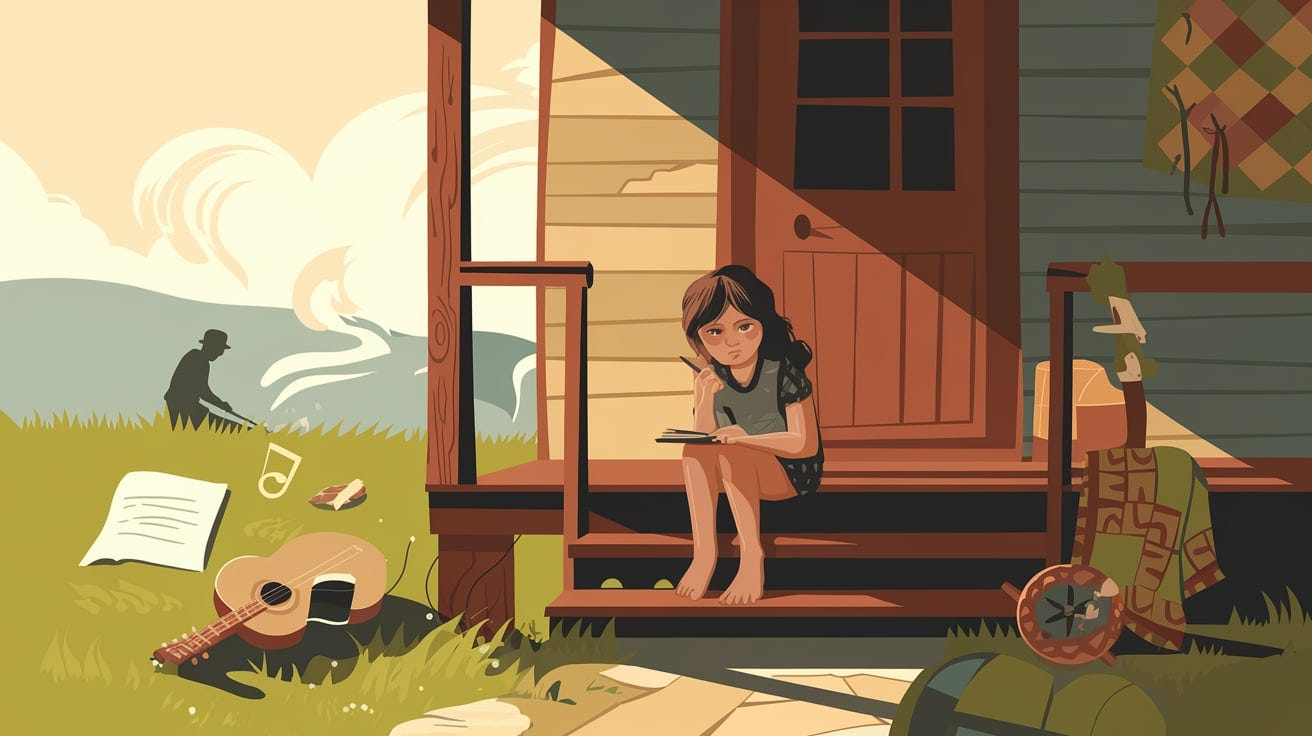How a Tennessee cabin, a hand-me-down guitar, and a rhinestone jacket taught me to write better content
It was a chilly morning in the Appalachian hills, per usual.
A young girl sat barefoot on the wooden steps of her family’s cabin, notebook in hand. She’d been up before the sun, her mind too restless to sleep.
Her father’s singing echoed from the field with the power to make you feel both the weight of the world, and an all-consuming hope for it, all at once.
It wasn’t the first time she sat on these steps trying to capture the whirlwind of emotions that life had thrown her way. Her family didn’t have much - not in money anyway. But what they did have was an endless stream of stories, passed down like heirlooms, each one richer than the last.
She thought about her mama, who sang through every struggle, and her daddy, who could fix everything except the holes life had worn in their pockets. The words she wrote weren’t perfect, but they were hers. Honest. Funny, at times. Other times, heartbreaking.
Her siblings teased her for spending so much time writing in her notebook. “What’s that gonna get you?” they’d ask. But she kept writing. Even then, she understood something most people don’t: there’s power in the stories meant to break us.
Did you know that 78% of consumers trust brands more when they’re honest about their failures?
For this young girl, her stories weren’t about strategy or marketing. They were about making people laugh through her tears. And those raw, unpolished moments she scribbled in her notebook eventually became the foundation of a music career bigger than she could’ve imagined.
The girl on the steps? Dolly Parton.
To this day, Dolly holds the record for most top 10 country albums - 49 in total - with more than 100 singles. She has won 11 Grammys and a slew of other awards, including a Lifetime Achievement Award and a spot in the Country Music Hall of Fame.
Dolly doesn’t just tell stories with her music; she creates worlds. Her songs, interviews, and even her persona have always been laced with vulnerability - disguised in equal parts wit, humor, and… rhinestones.
Her honesty about growing up poor, feeling different, and navigating heartbreak, turned listeners of her music into a loyal fanbase.
Her music connects because she doesn’t hide her flaws or try to be something she’s not, which is where most creators - especially those caught up in the hype machine of social media - get it wrong. They think they need to polish their stories before sharing them, when nothing could be further from the truth.
Here’s how to use my B.A.R.E. Method to master vulnerability in your content, like Dolly:
B – Break the Ice with Humor or Relatability: Start with something that feels approachable. A small moment or a simple truth that lets people in.
Example: “I’ve been rejected more times than I can count, but let me tell you about the time I got rejected twice in one day.”A – Acknowledge the Struggle: Don’t gloss over the hard parts. People connect with the messy middle, not the perfect outcome. Share a moment when things didn’t go as planned - it’s more relatable than your highlight reel.
R – Reframe with Growth: Vulnerability doesn’t mean wallowing. Show how you found hope, growth, or a way forward. It’s not just about what happened; it’s about what you learned.
E – Engage with Action: End with something your audience can do or reflect on. Give them a reason to apply your story to their own lives.
Example: “Next time you feel like your story isn’t enough, remember: the truth doesn’t have to be polished - it just has to be yours.”
Why This Works
A friend of mine always says, “People like their pastor to walk with a limp.” It always reminds me that people connect most deeply with leaders - creators, professionals, anyone in a position of influence - who show their humanity.
No one trusts someone who seems untouchable. A pastor who pretends they’ve never struggled can’t truly understand the burdens of their congregation. The same is true when building your personal brand - if you present a perfect image, your audience won’t see themselves in you, or your brand.
Vulnerability makes your brand relatable because it proves you’ve faced challenges, stumbled, and found your way through. Your limp isn’t a weakness. It’s what makes you, and your content, real.
When your audience sees you as real, they don’t just listen… they trust.
Here’s What You’ll Get Out of It
A method to create real, meaningful connections with your audience.
A framework to turn your mess ups into powerful tools for audiences growth.
A way to stop overthinking and start telling stories that show the real, even when it ain’t pretty.
Your Turn
Your next step isn’t just to understand vulnerability; but to practice it. Here’s how you can start…
Think back to a time in your life when you thought there was no way out of a situation you were facing. Write down three details about that moment: the setting, your emotions, and one action you took to get through it.
Ask yourself - what can my audience take and use from my experience? Jot it down in one sentence.
Then build a piece of content around it that focuses on the lesson rather than the pain, ending with a takeaway your audience can apply to their own lives.
Vulnerability doesn’t have to mean baring everything; just offering a little backstory… about your limp.



